The Maccabean Revolt › The Great Jewish Revolt of 66 CE » Origins and History
Articles and Definitions › Contents
- The Maccabean Revolt › Ancient History
- The Great Jewish Revolt of 66 CE › Antique Origins
Ancient civilizations › Historical places, and their characters
The Maccabean Revolt › Ancient History
Ancient Civilizations
After the death of Alexander the Great, his Kingdom was divided into four; Egypt, the Seleucid Empire, the Kingdom of Pergamon and Macedon (including Greece ). Egypt, governed by Ptolemy I Soter allowed for Judaism in Jerusalem to flourish with very little intervening in the 3rd century BCE. However, during the 2nd century BCE, the Seleucids having gained dominance over Judea went to enforce a dominion over Egypt and the Jews.
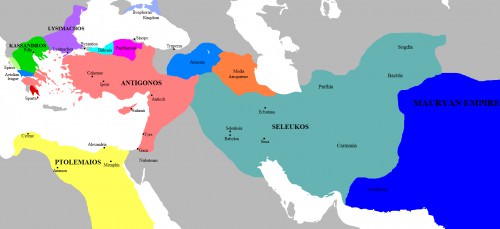
Map of the Successor Kingdoms, c. 303 BCE
JEWS UNDER PTOLEMAIC RULE
Theocracy and politics were intertwined in the 2nd century BCE in Jerusalem. The social structure of Jerusalem was run by the Jewish aristocracy such as the Priests and the High Priests. Although Hellenism, which had spread in the 3rd century BCE after Alexander 's conquests, was the dominant culture around Judea and the Greek way of life pervaded the area, the Jewish community remained steadfast to their own practices. They largely ignored Hellenism and, under Alexander and the Ptolemies, were respected in doing so. The Ptolemies gave the Jewish people their civil rights and they lived contently under their rule.
The Holy Temple was the most important structure to the entire Jewish community in Jerusalem. It was the social and religious centre of the Jewish people, not to mention the economic benefits of trading in the Temple. More importantly, however, it was considered a sign of God's presence amongst them. This feeling of the elect, the chosen ones, was crucial to the Jewish self-consciousness.
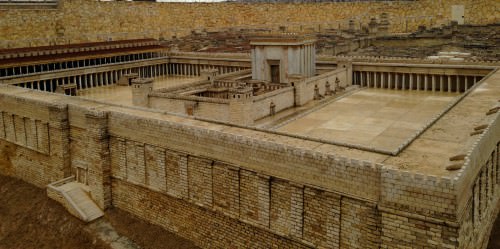
Second Temple Model
SELEUCID TAKEOVER
In 198 BCE, all of the goodwill of the Jewish community towards the governing body turned to hatred as the Seleucid Empiredefeated the Ptolemies, taking control of all Judea. As the Seleucid Empire expanded, so too did their notion of Hellenism. The Seleucids under Antiochus III controlled much of the Arabian Peninsula forcibly converting many of its new populace to Greek culture and religion, and the intent in that hegemony continued as they took Jerusalem. Antiochus wanted to Hellenize the Jewish community. His aim was to remove any features of Judaism that could define it from the Greek religion and other accepted monotheistic religions. Because of the benefits of the Greek culture, which included economic integration between all of the Greek states, and the pressure of regime, many Jewish people accepted Hellenism.
The already strained relations between the pious Jewish people that did not accept Hellenism and the Seleucid Empire were shattered when Antiochus Epiphanes adopted his father's policy of universal Hellenization but took it to new heights. As Epiphanes looked at Alexander the Great of Macedon and aspired to have his name in the history books alongside him, he needed to distinguish himself above his predecessors. The best way to do that, he thought, was to enforce the Greek culture on all of the Jewish population, a feat that had so far been elusive. He accepted a bribe and approved the take-over of Jason of the Oniad family to the now de-facto client position of High Priesthood. Antiochus used Jason's power as the High Priest over the Jewish people to build a gymnasium just outside the Temple, with that, strengthening the Greek culture in the heartland of the Jewish community. It was a symbol of Greek Hellenism and having it outside the Temple showed the Jewish community exactly who was in charge. The Hellenistic idea of masculinity was shown in the rule that one must be naked to enter the gymnasium. Being naked in public was strictly forbidden under Jewish laws, so any Jewish person that went into the gymnasium violated the laws of the covenant. The state understood this, and therefore, made it a legal requirement for anybody who could afford it to go at least once.
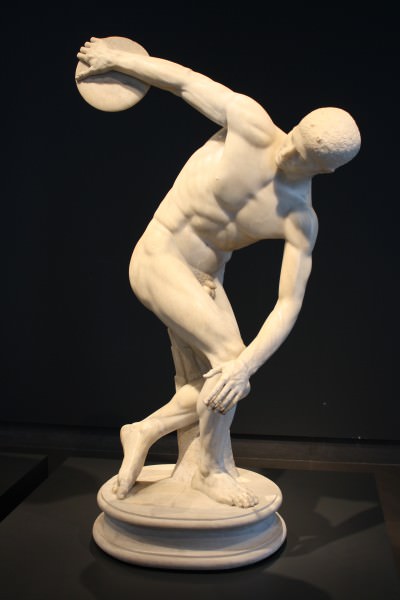
Discus Thrower (Discobolus Lancellotti)
This was a method of making the state bigger and of greater authority than any other religion other than the Greek polytheism, thus many Jewish people fell in line and acquiesced to the regime. Antiochus, buoyed by his success of the gymnasium, decided to push harder against the Jewish religion. A short-lived rebellion took place and when this was put down Antiochus' views were hardened. He defiled the Holy Temple, vandalizing it and erecting an idol on the altar. He then outlawed certain practices such as circumcision and the Sabbath. Altars to Greek gods and idols were placed in every town and those who did not pray to them and convert from practising Judaism were put to death.
REBELLION
Although many of the Jewish community were, at this point, Hellenized, the persecution of the Jewish people and the destruction of practicing Judaism united the Jewish people in Judea. The Jewish people needed someone to lead them. When Antiochus sent some of his officers to the town of Modiin to lay down his tyranny and enact the oppressive laws that he had enforced, he was met by a local Jewish country priest named Mattathias. This turned out to be a very portentous meeting. The country priest was ordered to fulfil his duty to the state and be the first to sacrifice an animal to an altar of an idol. He refused and when another Jewish man stepped forward to do it, he murdered the officer. Tearing down the idol, Mattathias preached "Let everyone who is zealous for the law and who stands by the covenant follow me!" (I Maccabees 2:27). The Jewish people had their leader. He and his five sons, John, Simon, Judah, Eleazer, and Jonathan, rallied the Jewish population. In 167 BCE, the Jewish people rose up, with Mattathias as their leader. Soon after 167 BCE, the family of Mattathias became known as the Maccabees or the hammer. They recruited tough Jewish people on the way and began a guerrilla war as they started to take over the northern villages of Judea. They tore down the altars of idols and killed those who worshipped them, even many Hellenistic Jews. Mattathias died in 166 BCE but just before death, he left Judah in charge of his army.
Antiochus underestimated the severity of the rebellion and the size and strength of the Jewish army. Instead of crushing them with the full force of his armies, he set his less effective generals on them. Judah, a wise and courageous military general, defeated them with consummate ease. Antiochus was made to look foolish. As a response, he set out to exterminate the Jewish population in Judea. Antiochus sent for his most glorified general, Lysias, and around 60,000 Seleucid soldiers to try and do just that.
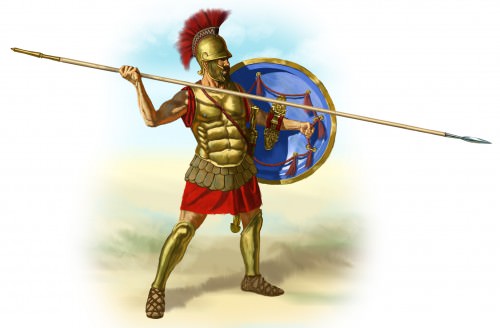
Greek Hoplite
Judah was severely outnumbered. However, the familiarity of Judea was a huge advantage for the Jewish army. Using the slight hills and the superior knowledge of the area, they outmanoeuvred the Seleucids and slowly they picked them off. Finally, they came to battle. Judah had gathered another 7000 Jewish rebels but still they were outmanned by at least five to one. As Judah stood there looking at the masses, so the story goes, he prayed to God for victory. The Jewish people overcame the massive difference in manpower to secure an almost impossible victory over the Seleucid Empire and over Antiochus.
After the defeat, Antiochus' armies were devastated. They met again when Judah's army was at the gates of Jerusalem, but it was a much shorter battle. The Seleucids were bereft of hope as Judah drove the enemy out of the Holy City. The Jewish army had defeated Lysias. When Judah and his brothers went to the Temple, he saw the destruction and defilement that Antiochus caused upon it and was overwhelmed by grief (I Maccabees 4:36-40). On December 25, 165 BCE, after months of work clearing and cleaning, the Temple was finally rededicated to God. Their celebrations continued for eight days as is known to this day as the celebration of Hanukah.
AFTERMATH
The Maccabees had accomplished their pursuit of religious liberty and were going after political independence. Although the Jewish people supported their fight against the shackles of religious desegregation, they were unsure of the political and cultural influence of the Maccabees. The Hellenistic way of life was already entrenched onto the Jewish people. However, after the Maccabees conquered the whole of Judea and enforced the collapse of the Seleucid Kingdom in Palestine, the Jewish people imposed themselves as an autonomous group. Judea was now free from the Seleucid rule and the death of Antiochus VII in 129 BCE confirmed this. The Jewish people were now content with the new political purpose of the Maccabees.Although no brother of Judah survived, with Simon being the last leader of the Maccabees who died in 134 BCE, their intention still flourished.
There is no general consensus on the nature of the revolt. Some see it as an economic and religious civil war, the Hellenised Jews that were propped up with the support of the Seleucid's against the zealous who could only turn to their religion. Whilst others tend to think that is was more than a class victory; it was an example of success in fighting against perceived oppression. The outcome, however, remained the same; the formation of the Hasmonean Dynasty, an autonomous Jewish rule over Palestine that would last a generation. The hopes of the Jewish monarchy was relieved. So too was the freedom to practice the Jewish religion. This experience would be vital in the history of the Jewish people, particularly in Jerusalem in the following century.
The Great Jewish Revolt of 66 CE › Antique Origins
Ancient Civilizations
The Roman Empire in the early 1st century CE was often regarded as the perfect empire. The outstanding military prowess of the Romans was used to expand the empire, and once the territories were acceptably pacified, Roman political power was installed from the capital of the empire to the local governments of the territories.
Perfectly balanced between a mixture of hard (military occupation and intervention to upkeep Roman law and instil Roman religion ) and soft power (entertainment, technology, and trade), Roman rule was generally accepted and enjoyed almost everywhere the empire landed. Some subjects of Roman rule were happy to trade their religious freedom in favour of the cult of Caesar for the benefits of sanitation, for example.
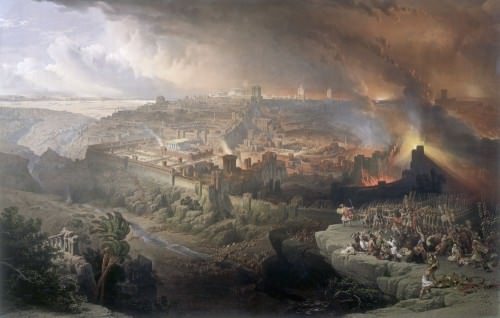
The Siege and Destruction of Jerusalem
ROMAN RULE IN PALESTINE
Palestine had long been Hellenised. Since 312 BCE, under Seleucos I Nicator, Greek culture flourised. However, after the Hasmonean dynasty, this Hellenisation became more than that of Greek culture and the cosmopolitan way of llife. With the Romanization of the Jewish Hellenised classes came a recrudescence of corruption that had previously flared under Antiochus IV Epiphanes and the Seleucid rule. The local Greeks and Hellenised Jewish elite supported the Romans and as such enjoyed the finer things that the Romans could deliver.The Jewish elite became more aware of their higher place in society and did whatever they could to keep the status quo. The Sadducees, the elite of which the Romans favoured, had the majority of the Sanhedrin (the ruling house) and defended Herod, the client king of Rome.
Not all Jewish people supported the Herodian stance, however. The Pharisees (who arguably merged into the Zealots) were deeply opposed to it and were incensed by the inroads that Hellenism continued to make into the Jewish religion. The Romans had unintentionally nurtured a class divide in the Jewish religion that was created under the reign of the Seleucids.
The ingrained corruption of the senate-appointed Roman procurator was transferred into the local Jewish and non-Jewish authorities. They ignored the plight of the Jews. Most of the profits of the goods that were sold in the markets of Jerusalem did not go into the Judean economy, rather they went straight to the elite, thus enraging the common Jewish man.
According to Josephus, a contemporary Roman Jewish historian who fought alongside the Jewish people in the revolt, the sheer ineptitude of the Roman governors of the province was the main cause of Jewish anger. The indifference and malice from the Judean governors reflected the malice of the emperors in Rome. When Pontius Pilate was elected by the senate to take the reins of the procurator of Jerusalem in 27 CE, the relations of the common Jewish man and the Roman people were in tatters. Pilate shared the same disdain for the Jewish people as Emperor Tiberius and quickly began to bring about a new kind of cult to replace the Jewish religion in the area.
In 64 CE, Gessius Florus presided over Judaea. He had the same indifference to the Jewish populace as Pilate but did not have the political intellect to calm the tense Jewish society when things turned sour. In other words, as Josephus states, Florus was incompetent.
REBELLION
The artificial class divide, the corruption of both the local and senate governments in the area, and the unbridled disdain for the Jewish people brought about a riot in Caesarea in 66 CE. There, the Zealots, a band of un-Hellenised anti-elite Jews, wiped out the Roman-backed elite Greeks that had inhabited the area.
Gessius Florus, in a rage of scorned hubris, plundered the Holy Temple to fund the cult of Caesar and erected statues of Emperor Nero and himself with the money he took. This obviously enraged the Jewish people. The temple was not only the centre of religious and social life for the Jewish people, but it was a sign of God's presence in the Holy City. When Florus raided the temple and ordered the residents nearby to follow his form of polytheism around it, it was the biggest insult to the Jewish religion. The Jewish people rebelled. Random attacks on Roman citizens followed throughout Judaea, particularly in the northern towns. There, in areas such as Narbata, the Jewish people overthrew the Roman government.
In response to this Jewish victory, the Roman legion in Syria, backed by the neighbouring Scythica, attempted to quell the Jewish rebellion. The Syrian Romans took large areas of the north of Judaea and Gallilee that had revolted without much effort. The Romans spread themselves too thin, however, and were ambushed and defeated on the coast of Judaea at the battle of Ben-Horon. This was a huge victory for the rebels. The Syrian Romans abandoned their posts and fled back to Syria.
Emperor Nero, angry at the impudence of the Jewish rebels, sent the Roman military general Vespasian to destroy the rebel armies and punish the citizens in the Judean province.
Vespasian and his son Titus returned stronger to Judaea with more men and slaughtered nearly every Jewish rioter in Caesarea and northern Galilee. Around 10,000 Jewish people were either killed or sold into slavery.
ROMANS AT THE GATE
The remaining Jewish rioters fled Caesarea to Jerusalem; there the Jewish people stopped paying taxes in the Temple and indiscriminately murdered Roman soldiers that were stationed there.
The Zealots and Sicarii overran the Roman military garrison from Jerusalem. This was a heartening victory for the Jewish people as support for the Zealots in the city grew. This sense of Jewish dominance over the Romans was short lived.
By the year 67 CE, the Romans under Vespasian and Titus had taken back all of Judea and killed the Jewish rebels that were left. The Jewish strongholds of Jodapatha, after a 47 day siege, was now under Roman control. The Romans were on the march to Jerusalem.
The perspective of the Jewish leaders in Jerusalem, mainly Sadducee Jerusalemites, had shifted dramatically from elation to panic. They knew that the revolt would not be a success for long, and they implored the Zealots to surrender peacefully in order to save as many Jewish lives as possible. The Zealots refused.
They anticipated the insurrection that would have doubtless come if the more moderate Jewish leaders were listened to by the common person. As a result, the Zealots and the fanatical Sicarii publicly executed them and hung their dead bodies so that everyone could see the repercussions of preaching insurgent messages of peace. The moderate leaders in Jerusalem at the start of the revolution in 66 CE had all been killed by 68 CE, and not one by the hands of the Roman aggressors.
Shortly before the siege of Jerusalem, a civil war broke out in Rome. Vespasian became the new emperor in 69 CE, and Titus, the second in command in the war, took up the reins. The Romans were at the gates of Jerusalem, in 70 CE, besieging the walls.
Once the panic had hit, there was no reversing it. Try as the Zealots might, they knew that the constant stream of different opinions held by different factions of Jewish people was a hindrance to the Zealot leadership inside the city. They wanted an all-out war instead of the war of attrition that some had planned for. The Zealots, led by John of Giscala, decided to further engage the population to participate in the revolution by burning the crops and dried foods that the Sadducees and the Pharisees had stored in expectation of the Roman siege.
This worked to some extent. According to Josephus, nearly one million Jewish people from both sexes, including children, signed up to defend the city after the burning of the food. It also had disastrous consequences. The city dwellers and the soldiers starved. Those who did not suffered due to malnutrition.
As the days went by, the Roman army accepted that the only way to reconquer the city was to set up a camp just outside the walls. It was a method of range fighting. Anyone that tried to escape the city was crucified and placed either on a cross or on a wall facing the city. Terrified, the Jewish population inside the walls knew that they had to fight or run a high risk of dying in the most disrespectful way imaginable.
ATTACK ON JERUSALEM
Finally, after a seven month range battle, the Romans had damaged the city walls enough to be able to breach them. In the summer of 70 CE, the Roman soldiers penetrated the city. The obvious military superiority was on show as the Romans forced the Zealots in to fighting on the streets. The Romans were destroying and burning the city and slaughtering the Jewish people in their wake.
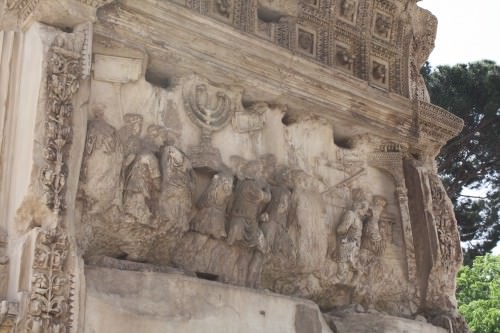
The Arch of Titus, Rome, depicting the Roman triumph at Jerusalem.
OUTCOME OF THE GREAT REVOLT
In all, Josephus claims, over one million Jewish people were killed. Jewish people were sold in to slavery and many were taken back to Rome. 70, 000 Jewish slaves built the Roman Colliseum. In Judaea, The Temple was destroyed and never rebuilt which instigated a new form of Judaism; Rabbinic Judaism. Rabbis were now the focal point of the religion, taking over from the High Priest. The synagogue became the centre of Jewish life, and with the diaspora, the Torah became the most invaluable source of knowledge for the Jewish people.
LICENSE:
Article based on information obtained from these sources:with permission from the Website Ancient History Encyclopedia
Content is available under License Creative Commons: Attribution-NonCommercial-ShareAlike 3.0 Unported. CC-BY-NC-SA License